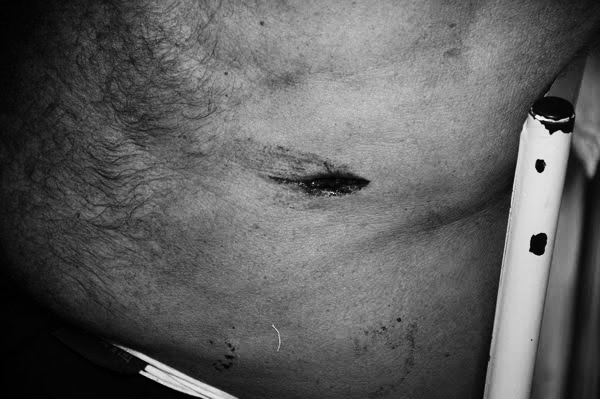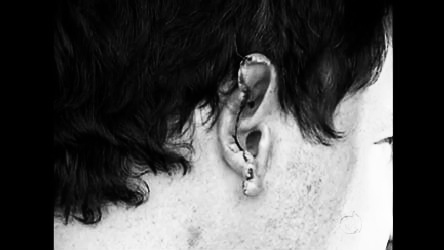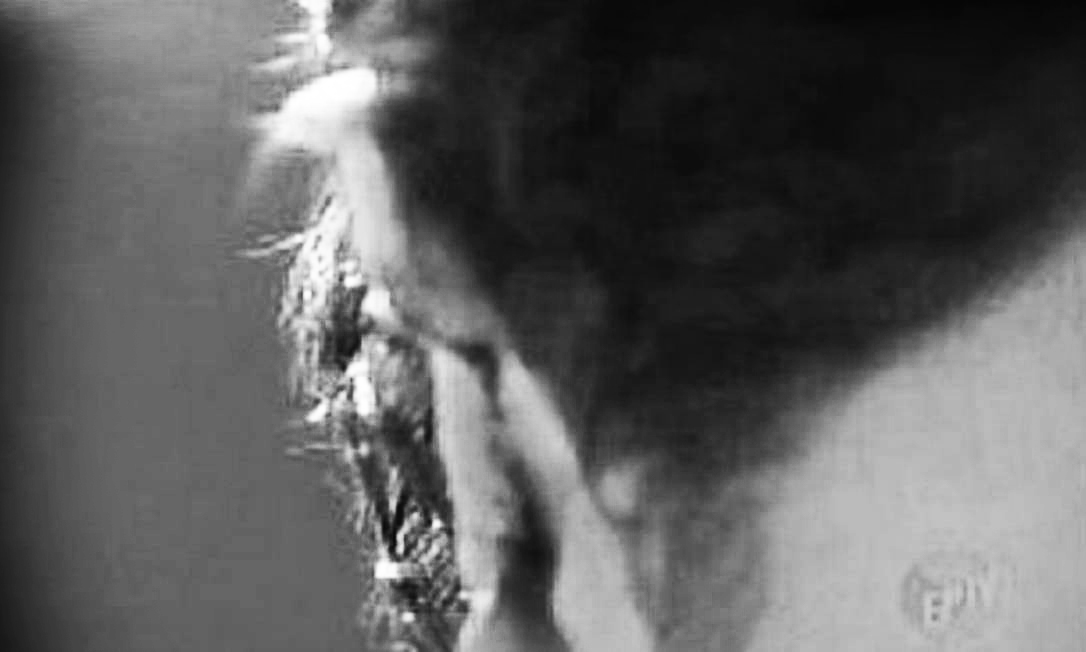




Scar Triptych over Belly – Being Migrator
5 minutes guided reading
The frame for contemplating this scar is that of a triptych.
(pause)
Three scars in one. Three openings in the skin to create the same work of art, the same trail. It also represents a triplet, three forces, three quantum values of the same physical question.
(pause)
The picture on the right, which is to the left of the beholder, is where the tweezers hold and cut the fissure, the inner rift. This is where the object exposes how much intestinal meat is on the verge of overflowing: the shit and rot. The scar contains one self, belonging to me, one which was both strangled and riven with rage at the sight of political persecution, homophobic violence, and the chauvinist rise to power. It is the self of mine that belongs to fear.
(pause)
The picture on the left, which is to the right of the beholder, is where the same tweezers open the inner space and then sew up the fortress, protecting the fissure created by the hernia. Healing, closing, covering, and guarding. The scar contains a self belonging to me, the self that for the first time felt loved simply for who he was and not for who he pretended to be. It is the self of mine that belongs to love, mirroring its opposite.
(pause)
The middle frame, which is also in the center for the viewer, is where the camera enters, witnessing the tension between the two previous ones. The new scar overlaps the fundamental scar of birth, two births. Actually, birth and rebirth. A tunnel to new life. Another scar upon the primordial wound, a new self, forged from fear and hate and love. Three small paths along three faces of the same self. The self of change.
(pause)
The problem or reason for the scar was lower, more underground, the young Hernia-being who inhabited the cave of the first and oldest Hernia-being. There are five Hernia-beings - mythological beings - living in this vast territory.
(pause)
The next one to be discovered is this, the oldest neighbor, but this story we leave for another encounter.






Parallel cases
During this process, I kept beside me three cases of violence. I did this so that I would not lose the political and social sense of this work and its repositioning of my body. We must always remember, we must always narrate so that we can exist.
The first is a case from 2010 (1), when a homosexual boy who was assaulted by a group with a long fluroescent light bulb. The case coincided with the beginning of my process of socio-political awakening, which is why it is so meaningful.
The second case, which took place a year later (2), happened in the interior of São Paulo, near the city where I lived. It marked me because it coincided with the death of my father, and its violence had a very strong significance for me. My father died before I could affirm myself as gay to him.
The third case happened when I had left Brazil and had just arrived in Belgium (3). The brutal and violent murder of Kelli da Silva was very striking because it happened right after the victory in the presdential elections of the extreme right in Brazil: a homophobic, misogynistic, racist, fascist, fundamentalist, and corrupt militia. I was marked by the fact that the reporting on this case never published the name chosen by the murdered woman, nor was it possible to know her face. There are many levels of erasing of the LGBTQIA+ body, especially the trans body, even in death. The story of Snow White, present in the performance that came out of this work, gained a very special meaning for me, and belatedly honours the memory of Kelli da Silva.
1- "I Thought I Was Going To Die," Says Young Man Assaulted With A Light Bulb In Paulista.
G1 News- São Paulo 2010
Four minors are suspects in the attack, which took place on the 14th of November and was captured on security camera.
Five young men were involved. Luis stated that one of the men was carrying two long fluorescent light bulbs in his hand. “Suddenly, I hear a shout. By the time I look around, he's already hit me in the face with one of them. By the time I reached my hand to my face, blood was already coming out. He came at me again, and this time I tried to defend myself. The others started laughing. He used the broken-off bulb still in his hand," Luis said.
At this stage, the fight is still out of the camera's reach. A boy wearing shorts, named Jonathan, puts Luis in a headlock. "He goes and holds me tight. Then I stand still, I can't defend myself. The others are already starting to attack, punching and kicking me. They hit me on the head a lot," he recalls.
A security guard interrupts the beating and the suspects run away. "If it wasn't for the security guard, I would have died. They wouldn't have stopped." According to the investigation, a total of five people were beaten up by the group that weekend. "The images reveal excessive and gratuitous brutality, with no provocation," points out Felipe de Almeida, Luís' lawyer.
But this series of attacks may not have been the only ones. On Friday, another accusation against the young men emerged. A 37-year-old man approached the police and told them that on the 14th of March he was beaten up in Augusta Street, a popular bar and nightclub area in São Paulo. He recognized Jonathan and the minor who attacked Luís with the fluorescent bulb: "I don’t have a shadow of doubt about that. The minor immobilized me from behind, while Jonathan punched me in the eye more or less eight times. They really were trying to kill me," the victim recalls.
The man, a business owner, did not want to identify himself. He has broken facial bones and suffers a sinking of his right eye. "I knew, even though they said absolutely nothing, that this was a homophobic crime," he adds.
2- Mistaken For A Gay Couple, Father And Son Are Attacked In Countryside Of São Paulo; Man Loses Part Of His Ear
UOL News - São Paulo 2011
The Civil Police of São João da Boa Vista (SP) are investigating the assault of two men, a father and son, who were mistaken for a gay couple by a group of seven men. The attack took place during a large agricultural fair in the city at the weekend. The 42-year-old man lost most of his right ear. The 18-year-old boy was hospitalized, though he has since been released.
According to the police, the two men had their arms around each other when a group of seven young men asked if they were gay. When they answered no, the group left, but returned and started beating them up. The assailants have not yet been identified.
The organizers of the fair said they will collaborate with the investigation and that, at the time it occurred, at least 150 security guards and military police patrolled the event.
3- Man Confesses To Ripping Heart Out Of Trans Woman In Brazil
He Told Journalists She Was A 'Demon'
Daily News UK 2019
Police arrested a 20-year-old man in Brazil on Monday (21 January) for the murder of a transgender woman. The man subsequently confessed to the crime. Multiple Brazilian outlets have reported on the story throughout the week.
It also gained attention when trans actor and activist Maria Clara Spinelli tweeted about it. Authorities reportedly said that Caio Santos de Oliveira admitted to his crimes. He allegedly tore out the heart of the victim, 35, and then stole her electronic devices after sleeping with her the previous night. Police found her body with injuries to her face and a gaping wound in her chest.
Oliveira reportedly told journalists outside the precinct that the victim was a “demon.”
The crime occurred in Jardim Marisa, which is in the state of Sao Paulo. Oliveira now faces charges of robbery and felony homicide and remains in police custody. Officers initially arrested Oliveira because he showed ‘suspicious behavior’ and had various wounds on his body. As they questioned him, he eventually confessed to the crime and led police to a bar where they found her body. They found her heart wrapped in cloth at Oliveira’s home.
A terrifying and violent reality for trans people in Brazil. Less than a month ago, a transgender woman was shot 11 times and killed on her way to a gym in the country. Over the past several years, Brazil has had the most reported number of trans murders.
A 2017 report found 171 known trans murders, while last year’s report tallied 167 murders. This is almost more than 100 murders than the country with the second-highest record of trans murders, Mexico. A more general overview of the country found a high rate of violence against the LGBTI community overall. A 2016 survey determined that at least one LGBTI person in Brazil is murdered every 25 hours.
Clara Masiero, a doctor of law and member of the Brazilian Institute of Criminal Sciences, while speaking of Silva’s death, referenced the rampant transphobia in the country. “The cruelty, the fact that the perpetrator referred to the victim as a ‘demon,’ the religious references — there is a whole level of symbolism that brings us face to face with the reality of transphobia in Brazil,” she said.
Lawyer Paulo Lotti, who works for the Sexual and Gender Diversity Advocacy Group, reiterated Masiero’s point. He said this “level of cruelty is a relatively common indicator of transphobic hatred.”